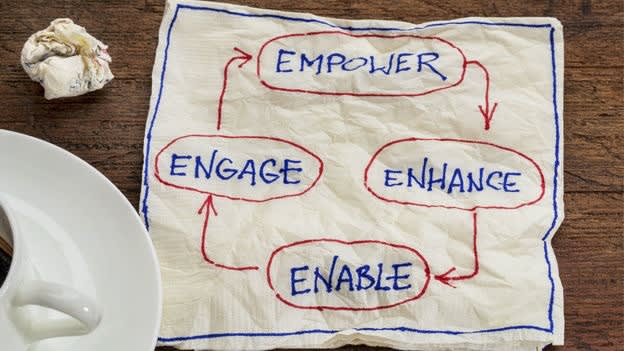Employee experience is at the core of culture

An organization’s culture is a cohesive part of its talent strategy; it is the magnet that attracts or repels talent. In essence, it is the kaleidoscope of organizational values that directs the direction and decisions. How people, both internal (employees, shareholders, directors) and external (customers, partners) associate and align with these values can make or mar the company’s performance.
A shift in cultural paradigm
The changing nature of the workforce is giving rise to changing cultural concepts. Compensation is no longer the only attraction for employees. Employees today are placing increasing importance on the intangible elements of the employer-employee relationship, such as benefits, work environment, leadership visibility and the nature of work itself. Employers must step up to meet these changing employee needs, they must turn to technology to create a compelling 'employee experience'. Gradually, we are seeing HR leaders apply emerging technologies to create interactive and engaging experiences, across the employee life cycle. It is almost as if an externalized 'customer-first' approach is now becoming internalized with 'employee-first'. The goal is to make HR interventions personalized, humanistic and memorable.
Here is how you too can revolutionize the employee experience in each of the talent management buckets.
Understand employee engagement levels
Step into the shoes of your employees and recognize them as people: their needs, aspirations, milestones, both personal and professional. Think of how they can be their best at work, every day. The first step in creating a compelling employee experience is to understand employees well and for this, use technology to 'listen' to what employees are saying. Use 'semantics analysis' and 'social pulse' mechanisms to analyze what and how employees communicate on company social platforms, email, chats etc. and plug in these findings into program designs.
Millennials greatly value the intangible such as work atmosphere and growth opportunities, forcing organizations to rethink the cultural concepts.
Make recruitment agile
The agile methodology of software development finds immense application in the recruitment process. GE Digital applied it and saw recruitment time-to-hire drastically reduce from 10-15 weeks to 2-6 weeks. The scrum-based agile methodology makes recruiters constantly reiterate their efforts and inputs, leading to timely course correction and better hiring metrics. Naturally, this leads to better candidate and employee experiences.
Design your workplace inclusively
The concept of the open workplace is catching on fast, however, these are most suited to extroverts. We must realize that not all employees are extroverts and introverts have specific work arrangement needs to be their productive best. Build spaces for collaborative work, while designing escape-nooks for focused, individualized work such as contemplation. HR should aim for flexibility, that is, give employees the choice to suit their work needs. Work ergonomics greatly affect the employee experience and must be in line with diversity and inclusion agendas.
Make performance management fluidic
Turn to consumer marketing tools to make performance management a positive experience. Apply the requisite consumer marketing tools such as behavior analytics and social tools and create new performance management experiences. This will help spread a culture of coaching and ongoing feedback. Many companies have discarded forced ranking in favor of frequent feedback-oriented 'check-ins'. Train your supervisors to coach for motivating employees, not reprimanding them. Outline developmental agendas at the outset and focus performance discussions on employee development.
Onboard through technology
eOnboarding is the latest in onboarding, it incurs engaging with new hires even before they join. Make onboarding an anytime, anywhere affair by turning to mobile onboarding apps- not only does it help engage constantly, but creates a great brand impression in the mind of a new joiner. If possible, complete joining formalities and allocations online beforehand, so that the first day is invested in person-to-person interactions and leadership meets. Alternatively, have social-induction with video podcasts and voiceover text modules to orient new hires to the company, industry, culture, and processes.
Automate HR policy and operation management
Imagine a situation where you ask your Alexa app about the latest leave policy, and pat goes the answer! If you can get your query resolved through chatbots and voice assistants in your personal life, you certainly can at the workplace. Explore artificial intelligence as a great tool for HR communication. Moreover, robots can take over transactional work like scheduling meetings, this leaves your employees with more bandwidth to take on value-adding work. A great experience to have!
Create new career paths
The Gig Economy is here, with different kinds of professionals- full timers, part timers, freelancers, contractors, consultants etc. working together. HR leaders must create the right roles and define talent demands adequately to create a great experience for each of these very different professionals. Create new career pathing and succession models for new work arrangements with specialized roles, start with drafting the job descriptions and role profiles right.
Employee mobility
Millennials want new and challenging work avenues periodically and to make this happen, HR must provide for employee mobility. Plan to incorporate mobility as a core component of the employee value proposition, with the right checks and balances in place. For example, build career mobility platforms allowing employees to test new roles while in their current roles. Or provide skill enhancement and transfer opportunities as a part of the career plans.
Focus on employee wellness
Design and deploy holistic wellness plans which include health, financial, emotional and spiritual wellbeing. Tie up with a counseling center and offer a counseling program to your employees. It shows you care for them and elevates the employee experience multifold. If needed, invest in the latest fitness wearables and launch initiatives like wellness contests and classes to pump up the wellness quotient.
Learning and development
The modern workforce is highly curious and thirsty for growth. Apply agile methodologies to learning to make it more relevant and focussed to the learner’s needs. Consider investing in mobile learning management systems and tie up with universities to deliver MOOCs- massive online open courses. Design a social learning platform where shared learning and exchange of ideas will happen by searching, rating, tagging and sharing learning content and experiences.
Conclusion
Creating a compelling employee experience comes from an optimum mix of digital and human interaction. HR leaders must don the innovation hat and also get into the shoes of today’s employees to create an attractive employee value proposition and live up to it. A great employee experience is contagious and can create the right employer brand to attract, retain and engage the best of talent.











